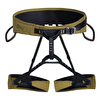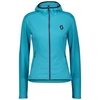Hervé Barmasse, Iker and Eneko Pou and the new Brouillard route up Mont Blanc
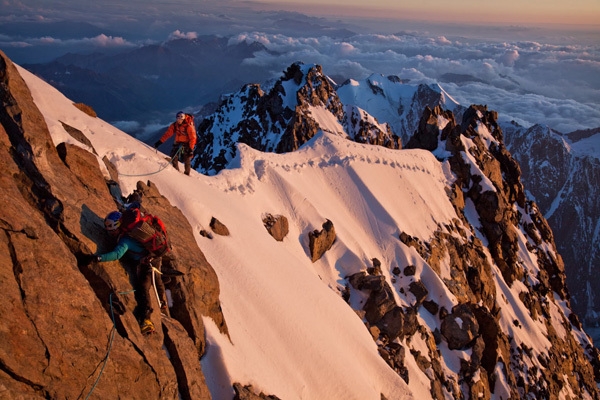
 1 / 6
1 / 6 Hervé Barmasse
Hervé Barmasse
We'd promised it. And so here it is, the interview with Italian alpinist and mountain guide Hervé Barmasse and the Basque brothers Iker and Eneko Pou who recently established a new route up the Left Pillar of Brouillard, right in the wild heart of the Italian face of Mont Blanc. None of the three alpinists need introducing, which means we'll leave you straight away to discover what they had to say about their latest adventure. But not without reminding you that this route is called, emblematically, "La Classica Moderna" the modern classic - you'll find out what's behind the name in the interview. It's worth remembering that this climb forms part of Barmasse's trilogy project entitled Exploring the Alps: after his solo of Picco Muzio on the Matterhorn in April, this latest climb is the second step. Above all though we feel we need to underline that adjective once again, wild, used to describe the grand Brouillard Pillars, to which we'd also like to add "magical". Trust us... check out for yourself (with due care and attention) to believe us.
INTERVIEW WITH HERVÉ BARMASSE, IKER AND ENEKO POU
by Vinicio Stefanello
Let's begin with... the end. For all three of you: an adjective or phrase to describe this new route up the Brouillard Pillars, alias the South Face of Mont Blanc...
Iker: Beautiful, precious, unique.
Eneko: Suggestive, the ambient is impressive, very winter-like
Hervé: Alpine, but at the same time Patagonian in view of the conditions we encountered.
Hervé, why did you choose the Brouillard Pillars for this second stage of your project? Where did the idea come from and what does this part of Mont Blanc represent to you?
Hervé: The most isolated, fascinating and severe corner of Mont Blanc has always been the Brouillard area. Seeing that my project wants to rediscover alpinism on the three highest peaks in the Alps, the choice couldn't have been anywhere else but here. Reaching the Eccles to then establish a new route up the pillars and continue all the way to the summit of Mont Blanc is, globally, far more difficult than establishing an ice climb on any other part of this mountain or a rock climb which is technically harder. We could easily have done this since one of the partners was Iker Pou, a climber with 9a+ to his name.
Iker: While ascending up to Monzino beneath the downpour and, above all, with snowfall just above the refuge, we would all have preferred to establish a new line up the West Face of Aguille Noire. Perhaps a difficult, technical route, but it would no longer have been an alpine outing, rather, just another of the numerous rock climbs.
Eneko & Iker, had you ever been to the Brouillard before and what impression did you get?
Iker and Eneko: No, never.
Eneko: As wild as Patagonia and as big as the Himalaya.
Iker: It's a spectacular face and, perhaps due to fatigue or too heavy rucksacks, but I imagined the ridge which leads to the summit of Mont Blanc to be much easier.
Before talking "seriously" about the route, I'm intrigued by something else: Hervé, why did you choose Eneko & Iker Pou as companions for this adventure…
Because they are "sport climbers" who are well suited to the "grandes courses" in the mountains. And then of course it's common knowledge that Basque people are determined, just like those from the Valle d'Aosta...
Eneko & Iker: what convinced you to accept Hervé's offer?
Eneko: We first met Hervé in Patagonia and after our winter experience in Pakistan last year we promised we'd join forces and climb together. And establishing a new route up Mont Blanc was a great occasion for all of us.
Let's get down to some technical details. And begin with the Pillar where the new route runs... can you describe your route? Are there others? And what line does it follow?
Hervé: We had initially chosen a different line, but as often happens in the mountains there was too much snow and ice, and as alpinists we were forced to adapt to these conditions. There are other routes on this pillar, jist like on all the others in the area, but there is still plenty of potential for new lines. Our new route runs to the right of that established by the Poles in 1971 and in the end it turned out to be far more beautiful than we had initially expected.
Tell us about the approach.
Iker and Eneko: from our point of view the approach is similar to the great faces in the Himalaya. Here you don't just need to know how to climb, what is fundamental is being able to cross glaciers in safety. And if you decide to ascend all the way to the summit, then the vertical height gain is plenty, 3300m.
Eneko: The route resembles those in Patagonia where often the biggest difficulty of all is being completely autonomous and fast enough to reach the objective.
How did you go about it, also in terms of time, condition and style of ascent?
Hervé: we intended to follow the style, philosophy and ethics of he who before us had been a great player on these pillars, Walter Bonatti - we say this without searching for useless comparisons, he is quite simply one of "greats" of alpinism. And this is another reason why we wanted to finish out adventure on the summit of Mont Blanc, without bolts and climbing fast - or as fast as one can be when establishing a new route alone, with sleeping bag, stove etc.
This second ascent forms part of a project which aims to rediscover the Alps and the origins of alpinism. On the Matterhorn the theme was to establish a route solo - something which is harder both psychologically and technically - while here we attempted to underline the meaning of a partnership and friendship which unites so many climbers across the globe.
The time has now come for the "obligatory move", at least for alpinists... tell us about the difficulties. And can you compare them with other routes?
Iker and Eneko: the route is reminiscent of "Super Canaleta" in Patagonia which we climbed a few years back, perhaps it's harder, also because when you establish a new route you always take more gear than necessary. Since no one had climbed it before they were no topos and so you never know what lies ahead.
Iker: the hardest section is 6c on rock and classic mixed along sections of the ridge which connect this pillar to the rest. The route turned out to be far more beautiful than we had originally thought when we looked at it from below, where the Left Pillar falls into second place behind the majestic beauty of the Rosso. Climbing the perfect Mont Blanc granite was a pleasure and there is no other place in the world with granite quite like this one.
At the top of the route you decided to continue on to the summit, which turned out to be a big undertaking compared to simply abseiling back down to the base... Why this decision, or, put in simpler terms: what are the advantages and disadvantages of this long haul up to the summit?
Hervé: Reaching the summit of Mont Blanc after having ascended one of the Brouillard makes all the difference, above all if you're opening a new route: far more hours trudging uphill with heavy sacks, as well as the risk of violent storms which can surprise you late in the day. You must have diverse abilities: a good set of lungs and the desire to put in a lot of effort as well as knowing how to climb and progress up mixed terrain. Furthermore, when you establish a route, a bivy is practically an obligatory stop-off. On the other hand, abseiling down means being safely off the mountain in less than two hours, in the comfort of Rifugio Eccles, joking about without a worry in the world. Out ascent respected the philosophy and ethics of the first ascentionists of this pillar - Bonatti and Oggioni who climbed the Rosso right to the top of Mont Blanc - couldn't but finish on the summit, despite knowing full-well than more than half of the first ascentionist who established new routes on the Brouillard abseiled off.
You bivied before reaching the summit of Mont Blanc ... what was it like?
Iker: Spectacular, the most beautiful bivy we've ever had.
Hervé: an emotion which has no comparisons. We sat still, immobile, on that small ledge. No one moved, there was no action, yet that moment was as powerful and exciting as the climb itself. An unexpected present which rendered this climb even more beautiful.
The next day you summited. For you Hervé it was summit No. ? While for you Eneko and Iker, was it your first time? Tell us about your sensations...
Eneko: it was out second time on Mont Blanc, the first was 19 years ago with our father via the French side. Sensations? After having been completely alone for a couple of days, reaching the summit and finding 150 people was "particular". It suddenly seemed as if we were on a completely different mountain.
Hervé: as "Carellino" said with regards to the Matterhorn: "Not too often, and never via the same route..."
Hervé, one of the aims of your trilogy project was to state that there is still plenty of room for adventure in the Alps... after this second stage do you believe this holds true and why?
Herve: Yes. I think it's up to us to give meaning to our actions and our way of living and interpreting the mountains. There is no such thing as a better or worse thing, but if you're looking for adventure then you can definitely find it out there, even on the mountains close to home. For example by going out of season, in winter, perhaps far away from the cable car or mountain huts, by establishing new routes or repeating existing ones in the style and in line with the philosophy of those who established them. Seeing that we're on the subject, I really didn't appreciate those bolts on the Bonatti route on the Red Pillar.
Iker and Eneko… this is your second year "travelling" across the Alps. What can you tell us about this... and are you nostalgic about your Pyrenees?
Iker: we're always homesick for our Pyrenees... We almost felt at home during our trip through the Dolomites. Even if they are far more vast that the Pyrenees, the Dolomites are very similar to our peaks. The Western Alps on the other hand - for example Monte Rosa and Mont Blanc where we spent the last days of our travels - are more similar to the Himalaya. Grand, enormous glaciers, high altitude and lots of elevation gain.
Let's finish classically... what will you treasure about this experience, what does it mean to you and,perhaps even, what aren't you happy about?
Hervé: I'd like to cherish everything. Even our moment of weakness at Rifugio Monzino when, on seeing the poor conditions and plenty of snow, we would have preferred to climb up nearby Aguille Noire and perhaps establish a hard new rock climb and now be the "cool guys".
Iker & Eneko: Ah yes... But it was worth continuing up just for that bivy!
A thought about your future and, if you want, that of alpinism...
Iker & Eneko: Less sport climbing and more adventures, like this latest experience. We certainly won't ever stop climbing difficult routes across the globe, both at the crags and on big rock faces, but at times the comparison with alpinism proves to be an eye opener.
Hervé: For the time being I want to finish my project off as best possible and attempt to tell a different story. The Matterhorn gave me a committing and severe alpine undertaking "at the limit" and with this and the next climb up Monte Rosa I hope to succeed in bringing to the forefront a far more romantic way of interpreting the mountains and alpinism.
| Planetmountain | |
| News Hervé Barmasse | |
| News Iker & Eneko Pou | |
| Expo.Planetmountain | |
| Expo Grivel | |
| Expo The North Face | |
| www | |
| www.hervebarmasse.com | |



 Copia link
Copia link

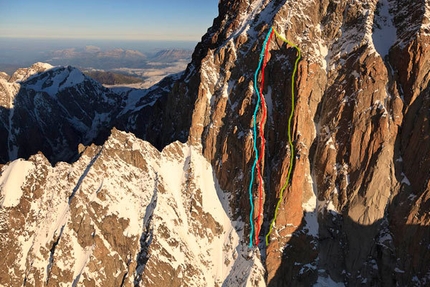
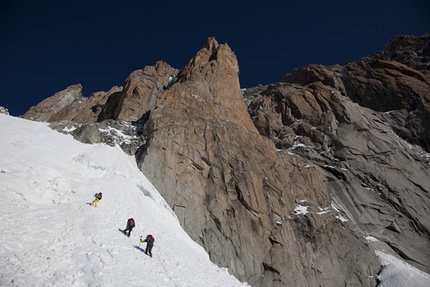
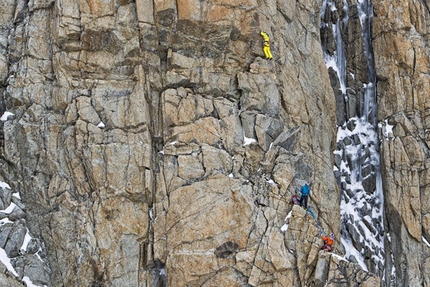
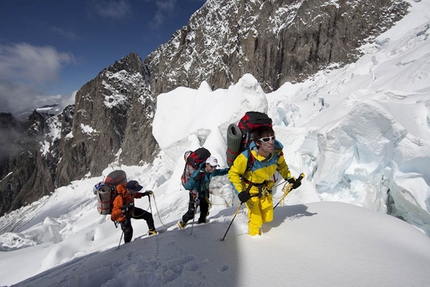
 See all photos
See all photos















